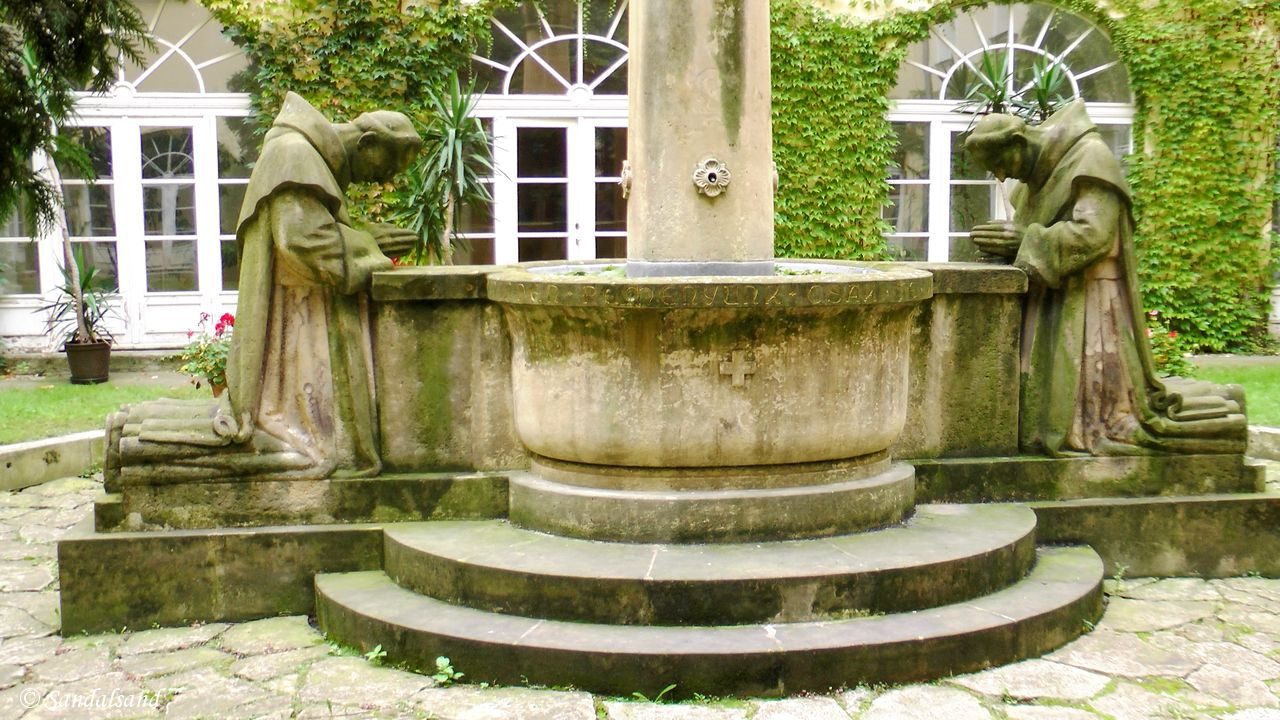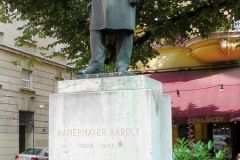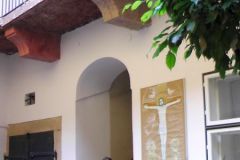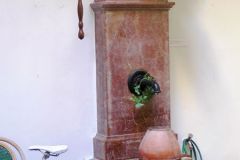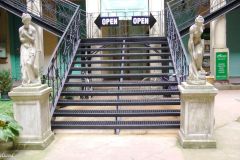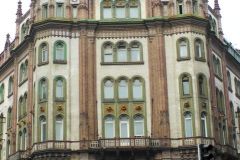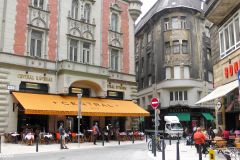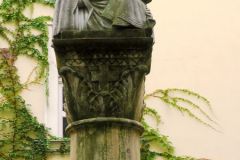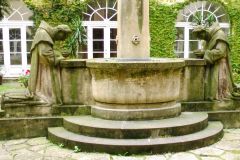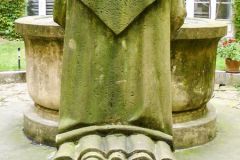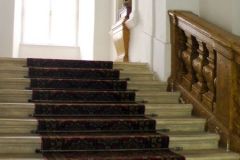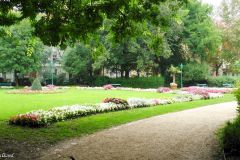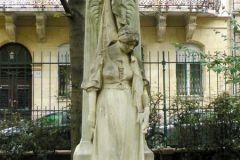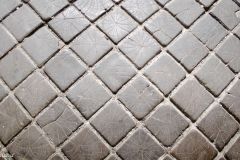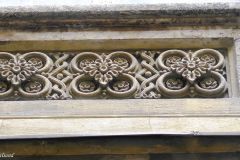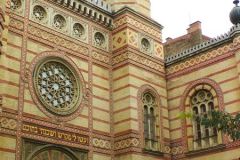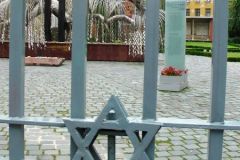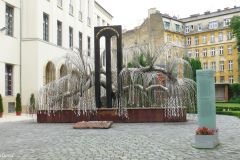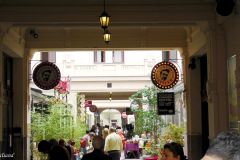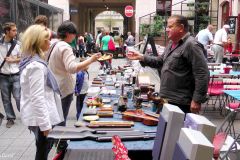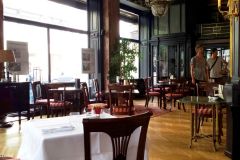The famous monumental sights are easy to find. For a change, join me for a walk to the nice little gardens and hidden courtyards in Budapest.
Budapest’s parks
There are many parks in the city. Népliget, Margit Island and Városliget are the large parks on the perimeter of central Pest, but there are also famous and popular green squares like Erzsebet in the downtown area.
In addition there are the obscure parks and gardens. You may also find yourself walking the busy, noisy high streets unaware of what is hidden behind that particular double door or obscure gateway.
What is behind the weary façades, at the end of the long tunnel? Is there a garden, or even a little park? Or is there a courtyard inside? Is it private or public?
The other (green) lungs
Some of these places will be closed for all but the specially invited, so you might have to settle with this article. Others are free to explore and you are encouraged to do so. We had the advantage of being part of a group with a very knowledgeable local guide. I’m only sharing some highlights from the 2-3 hour long walking tour with you. (Check it out)
The map below shows our route. Zoom in and out, click the markers for more information and open the map in a larger version if you like. This walk is the blue route, marked #1.
Let’s start, at Deák tér (square)
This square is part of the larger park called Erzsebet Square (Elisabeth in English). There is a ferris wheel that is easily recognised. For us it was merely a convenient starting point for the walk down the Sütö utca (utca is street in Hungarian) and on to the Bárczy István utca and Városház utca before turning left on the Vitkovics Mihály utca. Here we reached our first destination.
(I am including all these street names in case you want to print this article and bring it with you next time you’re in Budapest.)
Kamermayer Károly tér (square)
This is a square only by name (tér means square in Hungarian). In physical terms it holds the shape of a triangle and there is not really much to it. It is quite small. At the widest end there is a very nice little café which would have been nice to sit down in, or rather outside. There was a peaceful, kind of Parisian atmosphere about this square.
There’s a tree here. So what?
Well, the point is that Budapest once used to be a city without trees, so they decided to plant some. This particular tree is not more than 40 years old and it is rare.
The statue on the picture here is of the first mayor of a united Budapest. Budapest used to be divided into three parts and it was with Karoly at the helm (1873-1896) that much of what we today recognise as Budapest, was built.
Vitkovics Mihaly utca (courtyard)
Most of the buildings around the Karoly Square date from the late 19th century. Our next visit is to a place from the late 18th century. Just a few metres up the road, at (roughly number) 12 Vitkovics Mihaly street there is a nice little courtyard found behind a narrow door and archway.
Pest may look old but in fact very few buildings date back more than the late 19th century. A building, or any physical structure, from 1796 is a rarity here. The reason is that the banks of the Danube in 1838 succumbed to the pressure and the city was flooded with icy water. During this flood reaching 9 metres high, most of the city was destroyed and they had to rebuild it – in addition to reinforcing the river banks.
This house is typical of the buildings of its time: Two-three storeys built around a small inner courtyard. This place is private, but I believe you could ask at the gallery next door to let you inside.
Kossuth Lajos utca (courtyard)
We continued our walk up the Vitkovics Mihaly utca and turned right at the Semmelweiss utca. Another right turn brings us into the much larger Kossuth Lajos utca. This street leads traffic to and from the Erzsebet Hid, one of the bridges across the Danube. The street used to be narrower, but it is was redesigned in the late 19th century. They first constructed new apartment buildings around central courtyards, up to five and six floors, behind the older, lower ones. Then they tore down the older buildings on the Kossuth Lajos rendering a wider street.
Walking towards the bridge we found an obscure entranceway on the right hand side, it could have been at number 14-16 Kossuth Lajos utca. Inside there was a squarely shaped courtyard. The architect had made sure that each floor was given an individual look, so the view from below is many-faceted.
At this place we found the first evidence of what the privatisation policies of the 1990s led to: Deterioration. All tenants bought the apartments they lived in, and nobody could afford to pay for the maintenance of the exterior. I may be in confusion about this, for the process of deterioration must have started decades ago judging from what we witnessed.
In any case, this would have been a great place in the late 19th century.
Párisi Udvar (Parisian Court)
At this point we deviate a little from our guided walking tour because I would like to include a most wonderful place. As the map shows we crossed the Kossuth Lajos street before being able to study the interior of the Parisian Court. Fortunately we had seen it previously anyway and we were able to shoot some exterior photographs like the one below.
This used to be a magnificent shopping arcade, mixing Art Deco with a number of other styles. The glass-covered roof let the sun shine in on what is now a closed-off, emptied shell. One might be lucky and get inside during daytime, like my partner did, but not when we both arrived in the evening. Rumours have it that private enterprise is on the way to restore it, and it deserves it.
Egyetem cloister garden
Back on the right track again we walked up the Ferenciek tere and on to the Károlyi Mihály utca passing the Centrál Kávéház (coffeehouse), pictured below. If you have time, stop here for a bite and a cup of coffee, if not have a look inside anyway. It is one of those nice, elegant and old cafés of Budapest.
Coming up next on this walk among hidden courtyards in Budapest is the Egyetem tér (University Square). The Faculty of Law is situated in a proud building and you will have the Egyetem Templom (University Church) to your right. The square is very nice especially now after it has been turned into a pedestrian area.
We are looking for something else, however.
.
To the right of the church entrance there is a long yellow building. Number 7 Papnövelde utca has a double door and a signpost stating Seminarium Centrale. We are let inside, a guard writes a receipt to our guide, and we walk into what used to be a Theological College belonging to the Pauline order. Long whitewashed corridors have a series of brightly coloured religious murals in the ceiling, and they lead out into the cloister garden. This is what we have been looking for.
There is a quiet, serene atmosphere here. The cloister garden has a formal layout with evergreens planted around us, and a fountain-statue as the focal point. The surrounding seminary buildings are only three-four storeys high, and apart from the side with the University church, one gets a feeling of openness towards the sky (heaven if you like).
The “Fountain of Peace” or Paulines Fountain (1916) consists of a marble column with Christ and his mother on top. The column is set in a limestone water-filled basin covered by water lilies and with two praying monks on the sides. The sculpture is 7 metres high.
Petöfi Irodalmi Múzeum (courtyard and garden)
Back in the street we retrace our tracks to the University Square again and backtrack another little bit. In Károlyi Mihály street we locate right away the Petöfi Irodalmi Múzeum (Museum of Literature) in what used to be the Károlyi Palace. The wealthy family built and rebuilt their palace several times during the 150 years that followed their purchase in 1769. We did not enter the museum, but followed the sign to the courtyard restaurant through a long passageway laid with cobbled stones – or rather not stone but wood.
The courtyard is nice, but the garden is apparently not what it used to be. Besides, it has been cut in half. The other half is our next stop and to reach it we will have to walk around the block.
Karolyi kert (park)
Walk back to the Károlyi Mihály utca and turn left into the Henszlmann Imre utca. You will soon find the garden or rather park bearing the name of the Karolyi family.
This is an oasis, hidden in central Budapest, and very beautiful. It has a quite formal layout – kind of English – with lawns, flowers, gravel paths, benches and even two playgrounds.
The funny thing is that the owners of apartments adjacent to the park, were obliged to pay a special tax. What for? For the view, of course.The park is enclosed by a high, ornate fence and has even a very special statue in the farthest corner (from where we entered). Even if you are not on this walk I am describing, the Károlyi garden/park is a place to visit.
Magyar utca (courtyard)
We cross the garden diagonally and end up past the statue in Magyar utca. After a very short while, I think it was at number 8-10, we looked inside a door on our right. Here there was another amazing courtyard.
There is more to this place. The mapped route among hidden courtyards in Budapest is not correct at this point. You actually walk straight through this block and emerge on the busy Múzeum körút and not via Kossuth Lajos.
Károly krt (courtyard)
We have now left the quiet side streets of Pest and enter the noise on, first Múzeum körút and then the continuation of the same street but now called Károly körút. Before doing so you should have a look inside the Astoria Hotel. Beautiful old style, very good service and lunch with comfortable prices. We went there after the guided tour was over. (Have a look at the pictures at the end of this article.)
The Károly körút is a wide boulevard and part of the main thoroughfare of central Budapest. We walked on the left side of the road and our guide pointed out an obscure door, leading into a small courtyard. I think it was at number 4. It was a really nice place, even with a set of café tables where no guests had found their way.
As with the other hidden courtyards in Budapest, there is a well inside – obviously no longer in use.
Dohany street Synagogue
We only made a short stop at the courtyard before continuing on the Károly körút and crossing it at the next junction. To our right was the Great Synagogue of Budapest. It was built between 1854 and 1859 in a mix of styles, drawing inspiration from Moorish architecture as well as Christian churches. It is the largest synagogue in Europe and the property also houses a Museum. The synagogue was closed on our visit but we managed to look into the modern court walking up the Wesselenyi utca.
Gozsdu Udvar (courtyards)
Our walk among the hidden courtyards in Budapest was about to come to an end. Coming up was the grande finale. Gozsdu Udvar is a series of seven buildings with six connected courtyards between the streets of Dob utca, where we entered, and Király utca.
The complex is named after Mano Gozsdu, who at the turn of the century (19th to 20th) played an important role in the Romanian national movement and the Hungarian reform era, according to a sign outside the entrance.
On our visit the entire length of this 240 metre long passageway was filled with vendors selling all kinds of things, it was like a flea market.
The Gozsdu was in the middle of the former Jewish quarter of Budapest. There used to be, and after extensive renovations still are, a mix of workshops and restaurants on the ground floor and apartments higher up.
It was very lively here but according to our guide the night scene in the Gozsdu Courtyards rocks even more. There are plenty of places to quench your thirst and satisfy your hunger.
Kiraly street (courtyard)
After the lively Cozsdu Court we emerged on what is called Budapest’s Design Street and turned left.
At 9 Király Utca we found our last courtyard and garden, walking through a combined café and shop called Arioso. Fences prohibits any attempts to enter elsewhere, but in the old days of the Jewish community, they would have been able to move between the residential buildings without having to walk the street outside.
One could easily spend more time in the gardens, parks and hidden courtyards in Budapest, even looking for more “secrets” as well. We were satisfied and settled for a cup of tea with the rest of the group.
Further reading
This article about hidden courtyards in Budapest is the first of several entries from Budapest following a visit in September 2014.
(1) Harmonious gardens and hidden courtyards
(2) The Pest side of the Danube
(4) The Buda side of the Danube
